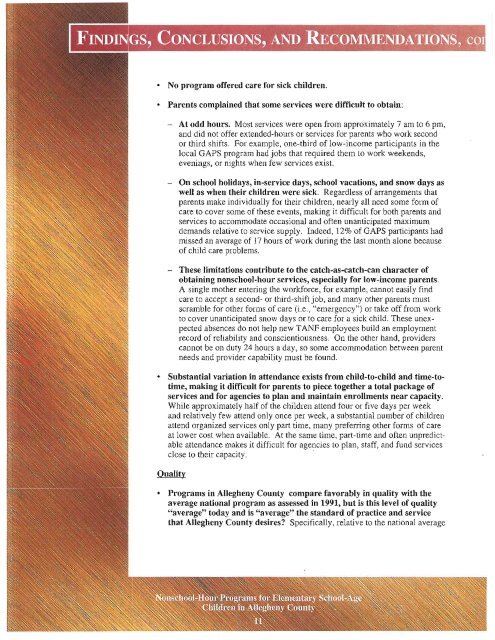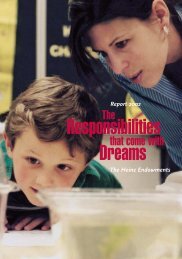View PDF - Heinz Endowments
View PDF - Heinz Endowments
View PDF - Heinz Endowments
You also want an ePaper? Increase the reach of your titles
YUMPU automatically turns print PDFs into web optimized ePapers that Google loves.
. No program offered care for sick children.<br />
. Parents complained that some services were difÍicult to obtain:<br />
- At odd hours. Most services were open from approximately 7 am to 6 pm,<br />
and did not offer extended-hours or sèrvices for parents who work second<br />
or third shifts. For example, one-third of low-income participants in the<br />
local GAPS program had jobs that required them to work weèkends,<br />
evenings, or nights when few services exist.<br />
- On school holidays, in-service days, school vacations, and snow days as<br />
well as when their children were sick. Regardless of anangements that<br />
parents make individually for their children, nearly all need some form of<br />
care to cover some of these events, making it difficult for both parents and<br />
services to accommodate occasional and often unanticipated mãximum<br />
demands relative to service supply. Indeed, r2vo of GAps participants had<br />
missed an average of 17 hours of work during the last month alone because<br />
of child care problems.<br />
- These limitations contribute to the catch-as-catch-can character of<br />
obtaining nonschool-hour services, especially for low-income parents.<br />
A single mother entering the workforce, for example, cannot easiiy find<br />
care to accept a second- or third-shift job, and many other parents must<br />
scramble for other forms of care (i.e., "emergency") or take off from work<br />
to cover unanticipated snow days or to care for a sick child. These unexpected<br />
absences do not help new TANF employees build an employment<br />
record of reliability and conscientiousness. on the other hand, providers<br />
cannot be on duty 24 hours a day, so some accommodation between parent<br />
needs and provider capability must be found.<br />
' Substantial variation in attendance exists from child-to.child and time-totime,<br />
making it difficult for parents to piece together a totar package of<br />
services and for agrncies to plan and maintain enrollments near capacity.<br />
\Mhile approximately half of the children attend four or five days per wèek -<br />
and relatively few attend only once per week, a substantial number of children<br />
attend organized services only part time, many preferring other forms of care<br />
at lower cost when available. At the same time, part-time and often unpredictable<br />
attendance makes it difficult for agencies to plan, staff, and fund sèrvices<br />
close to their capacity.<br />
Quality<br />
'<br />
Programs in Allegheny county compare favorably in quarity with the<br />
average national program as assessed in 1991, but is this level ofquatity<br />
"ayerage" today and is 'raveraget' the standard of practice and seivice -<br />
that Allegheny County desires? Specifically, relative to the national average







